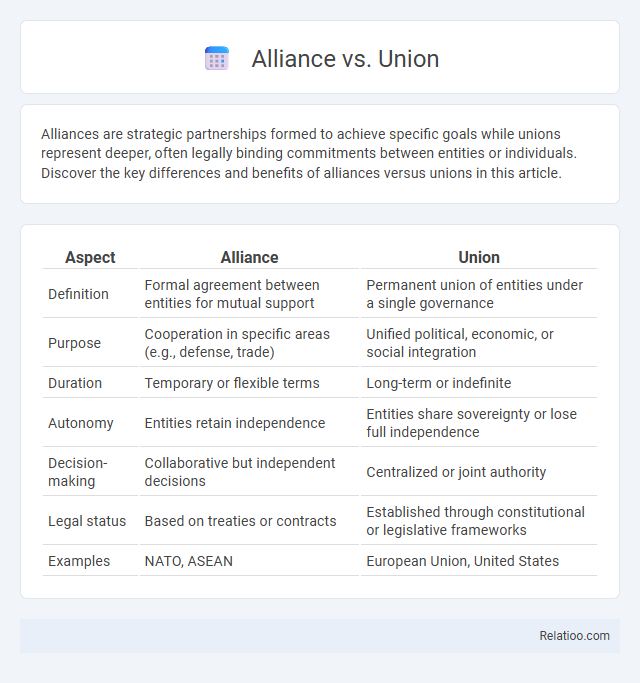Alliances are strategic partnerships formed to achieve specific goals while unions represent deeper, often legally binding commitments between entities or individuals. Discover the key differences and benefits of alliances versus unions in this article.
Table of Comparison
| Aspect | Alliance | Union |
|---|---|---|
| Definition | Formal agreement between entities for mutual support | Permanent union of entities under a single governance |
| Purpose | Cooperation in specific areas (e.g., defense, trade) | Unified political, economic, or social integration |
| Duration | Temporary or flexible terms | Long-term or indefinite |
| Autonomy | Entities retain independence | Entities share sovereignty or lose full independence |
| Decision-making | Collaborative but independent decisions | Centralized or joint authority |
| Legal status | Based on treaties or contracts | Established through constitutional or legislative frameworks |
| Examples | NATO, ASEAN | European Union, United States |
Definition of Alliance and Union
An alliance is a formal agreement between two or more parties to cooperate for mutual benefit, often in political, military, or commercial contexts. A union typically refers to a more integrated and lasting association, where members share common goals, governance, and often legal or economic ties. Understanding the difference helps You navigate relationships by recognizing that alliances are flexible partnerships while unions imply deeper unity and collaboration.
Key Differences Between Alliances and Unions
Alliances refer to formal agreements between independent entities to cooperate on specific goals while maintaining their sovereignty, often focusing on defense, trade, or political interests. Unions represent a more integrated form of partnership where member entities relinquish some individual autonomy to operate under a centralized governance structure, exemplified by political or economic unions like the European Union. The primary difference lies in the level of integration and sovereignty: alliances emphasize collaboration without merging governance, whereas unions involve shared authority and policies across members.
Historical Examples of Alliances
The Treaty of Versailles in 1919 exemplifies a historic alliance where Allied Powers united against the Central Powers in World War I, shaping geopolitical boundaries. The North Atlantic Treaty Organization (NATO), established in 1949, represents a military alliance aimed at collective defense during the Cold War era. The Hanseatic League, a commercial alliance of merchant guilds and market towns in Northern Europe from the 13th to 17th centuries, facilitated trade and mutual protection among its members.
Notable Unions in History
Notable unions in history such as the Industrial Workers of the World (IWW), the American Federation of Labor (AFL), and the Congress of Industrial Organizations (CIO) have significantly shaped labor rights and workers' protections worldwide. These unions successfully negotiated for better wages, safer working conditions, and fairer labor laws, influencing socio-economic policies during the Industrial Revolution and beyond. Their collective bargaining power differentiated them from alliances and informal partnerships by creating lasting institutional impacts on labor movements globally.
Purposes and Objectives
An alliance is formed between independent entities to achieve shared strategic goals without merging structures, focusing on cooperation for mutual benefit. A union typically represents a collective group of individuals, often workers, aiming to protect rights, improve working conditions, and negotiate labor contracts. An association serves as a formal organization that unites members with common interests to promote specific objectives, such as advocacy, education, or professional development.
Formation Processes: Alliance vs Union
Union formation typically involves collective bargaining processes where workers organize and negotiate terms with employers to improve wages, benefits, and working conditions, often requiring legal recognition and majority support. In contrast, alliance formation centers on collaboration between independent organizations or groups aligned by common goals, formed through mutual agreements without the need for formal labor representation structures. The union emphasizes member-driven democratic procedures, while alliances depend on negotiated cooperation agreements tailored to strategic partnerships.
Legal and Structural Distinctions
Alliances are informal agreements between parties without creating a separate legal entity, focusing primarily on cooperation for specific goals. Unions are legally recognized organizations representing workers' rights, structured with formal leadership, membership rules, and collective bargaining powers under labor laws. Unlike alliances and unions, federations combine multiple organizations or groups under a single overarching legal framework, allowing shared governance while maintaining individual entity autonomy.
Strengths and Weaknesses
Alliances offer flexible partnerships with diverse member goals, enhancing strategic adaptability but often lacking formal obligations, which can weaken long-term commitment. Unions provide strong centralized control and collective bargaining power, ensuring unified action, yet may suffer from bureaucracy and reduced individual autonomy. Coalitions combine the strengths of both by uniting groups for specific objectives, but their temporary nature and potential internal conflicts can undermine sustained effectiveness.
Impact on International Relations
Alliances shape international relations by formalizing cooperation between states to address common security threats, enhancing collective defense and deterrence capabilities. Unions integrate member countries politically and economically, fostering deeper collaboration that influences global governance and regional stability. Your understanding of these distinctions clarifies how alliances and unions differently affect diplomatic strategies and power dynamics on the world stage.
Future Trends: Alliance or Union?
Future trends indicate growing preference for alliances over unions due to their flexibility in adapting to rapid market changes and technological advancements. Alliances allow businesses to collaborate on innovation and share resources without the long-term commitments that characterize unions. Increasing digital integration and global competition will likely drive organizations to form strategic alliances to balance risk and opportunity efficiently.

Infographic: Alliance vs Union
 relatioo.com
relatioo.com